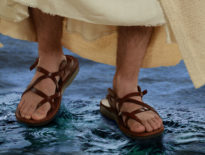Christianity is either historical or not. It claims that “God acted decisively in history, revealing Himself in external, specific events attested in the Scriptures of the Old and New Testaments.”[1] The most important of these events was the coming of Jesus as the Messiah, the saving Christ.
The average reader of the Bible relates to the historical information in its pages from the premise that what is being recounted is historical fact. Among experts, however, things are much more complicated. The area of New Testament studies dealing with these matters is called “Searching for the historical Jesus”.
The word “historical” suggests that the Jesus in the New Testament gospels may not faithfully correspond with the real Jesus of Nazareth. He could be a theological-literary character, created by the writers of the New Testament, later on. The phases of this search for Jesus as a historical entity are conventional, and there are three of them.[2]
The first two phases of the search in context
The Christian approach to the gospels before the Enlightenment was based on the assumption that the Bible is the inspired Word of God and that it contains accurate and reliable historical information about Jesus. Under the influence of rationalism, and also as a reaction to the control and authority exercised by Catholic ecclesiastic authorities on the sciences in general, this changed, and historical criticism (which implies the non-historicity of biblical accounts in the absence of ancient evidence, e.g. of an archaeological nature) started to be applied to the gospels.
As a result, a number of studies emerged which deny the supernatural element in Jesus’ life and activity. The core message of these studies is that the historical Jesus was a human being, embellished by supernatural descriptions that must be set aside to discover who He really was. From this perspective, even His status as Son of God is not considered superior to any human’s status as God’s child.
Every thesis has an antithesis. The result hereof was the reverse reaction, “the no-search phase” from the first half of the 20th century. Representatives of this new attitude concluded that such a search is superfluous since so little can be known about the historical Jesus, and the nature of the Christ of faith (even if He has no historical backup).
But researchers did not stop there. They initiated a second search[3], but reached the conclusion that the gospels do not contain much information about Jesus that can be regarded as historical, except for a few pieces: Jesus came from Nazareth, He was baptized by John, He taught others about the mysteries of the Kingdom of Heaven in parables, He claimed that His Kingdom would soon be inaugurated, people believed He performed exorcisms and healings, He had a small group of followers, He mingled with sinners, He opposed the Jewish leaders, and He was arrested and crucified by the Romans.
Contemporary approaches (the third search)
Nowadays, two completely opposite tendencies exist: one liberal and one conservative[4]. The first one takes the beaten path and dissociates Jesus from His Jewish roots, from the Church, the canonical Gospels and tries to define His historical existence based on noncanonical documents (e.g. The Gospel of Thomas, The Secret Gospel of Mark) and in light of the Greek philosophies of the time. The conservative approach underlines Jesus’ Jewish origin and past, His eschatological teachings and actions, the authenticity of a great part of the gospels, the priority of canonical gospels, and Jesus’ words and actions.
There are four tendencies in the new search for the historical Jesus.
A few extra words on the supernatural might be necessary. There are four tendencies in the new search for the historical Jesus. The first one is naturalist (there is no supernatural). The second one is anthropological (Jesus performed social healings, not physical ones). The third one is paranormal (we do not need to know how some supernatural things happen to accept them). The fourth one is supernatural. Scientists like B. Witherington and N.T. Wright say that it would be hasty to say what is possible and what is not, especially in parts of the world where the Enlightenment’s rationalist influence is insignificant.
The reader may observe that the problem is hermeneutical or methodological. The premises, methods, and instruments are what generate Jesus’ historical portrait in the end. If these methodologies derive from historical criticism, as is often the case, then the historical Jesus will not be the same as the Jesus described by the canonical gospels.
If the Gospels are regarded as historically trustworthy, then Jesus, as a historical figure, is the same as the One we read about in the gospels. Although the results of these methodologies have also had negative effects on the Christian faith, some researchers[5] believe that this search cannot be abandoned because, in its nature, Christianity is historically grounded. Let us close with an evaluation meant to signal the need to restructure this search from the ground up.
The search continues
An evaluation of these searches leads to the observation of two problematic directions[6]. The first has to do with false presuppositions and study methods. With very few exceptions, most researchers take the possible historicity of any story that includes a supernatural occurrence with a grain of salt. These researchers operate with the unjustified fact/importance dichotomy, derived from Immanuel Kant. This suggests that something can be important without being a real fact, which is simply not true except on a subjective level, and not in all cases.
However, as Norman Geisler said, Jesus’ birth of a virgin is of no importance if it’s not a biological fact.
The search for the historical Jesus also falsely separates the Christ of faith from the real Jesus, without any evidence that the facts recounted in the gospels are non-historical. In fact, Jesus’ non-historicity in the gospels is built on the alleged non-historical character of source documents (canonical gospels). However, this argument is unfounded. Actually, the historical authenticity of the gospels has been proven more than any other document of antiquity.
A corollary of this point is also the late dating of most of the New Testament books, in the attempt to suggest that Jesus’ character was not sketched by His contemporaries but by the church, at a later stage. Still, in many cases, there is solid evidence that supports dating many New Testament books before the year 70. Last but not least, to regard the gospels as a myth is proof of a lack of knowledge of both to the gospels and to the nature of myths. Just because an event cannot be empirically identified does not prove that the event is non-historical or impossible.
What are we left with?
Scientific methods often offer certainty to the one practicing them and generate an illusion of superiority. We should, however, listen to what Albert Schweitzer said, at the beginning of the 20th century, in the conclusions to his own research on the historical Jesus. First, he says: “The study of the Life of Jesus… set out in quest of the historical Jesus, believing that when it had found Him it could bring Him straight into our time as a Teacher and Saviour… But He does not stay; He passes by our time and returns to His own. What surprised and dismayed the theology of the last forty years was that, despite all forced and arbitrary interpretations, it could not keep Him in our time, but had to let Him go.”[7] The Jesus fashioned by the historical approaches to the gospels was not a character that would remain in Western civilization. His interpretation is so different from His canonical identity that civilized societies dispensed with Him.
It is the same Schweitzer who says that: “We modern theologians are too proud of our historical method, too proud of our historical Jesus, too confident in our belief in the spiritual gains which our historical theology can bring to the world. The thought that we could build up by the increase of historical knowledge a new and vigorous Christianity rules us like a fixed idea… There was a danger of our thrusting ourselves between men and the gospels, and refusing to leave the individual man alone with the sayings of Jesus.”[8]
Laurenţiu-Florentin Moţ, PhD, is an associate professor and rector of Adventus University.



















